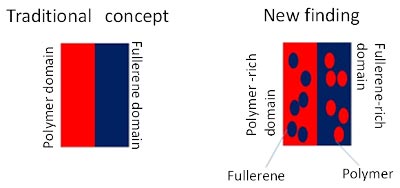Intermixing molecules key to energy conversion efficiency in solar cells

Figure 1 in the press release. The interface state as conventionally understood (left) and the interface structure in which we observed intermixed molecules in this study (right)
Using a soft X-ray microscope, a Japanese research team has examined the nanostructure of organic solar cells and discovered that different molecules are intermixed in each molecular domain.
This discovery is expected to reveal the energy conversion mechanism in organic solar cells and thereby facilitate the establishment of guidelines to design high efficiency organic solar cells.
Bulk heterojunction organic solar cells are characterized by their high energy conversion efficiency. In order to improve the efficiency of cells, it had been thought to be important up until now to have a clean interface between a polymer material and a single molecular domain of a fullerene.
However, when the researchers carefully examined the domain structure of cell materials that were optimized for energy conversion efficiency using a new methodology involving a soft X-ray microscope, they found that different molecules were intermixed in each molecular domain.
In other words, they found that cells with a “dirty” interface have superior performance to those with a “clean” interface. This new discovery defies the common understanding of the energy conversion mechanism.
These results were published on April 16, 2014 in the online version of Applied Physics Express, a journal issued by the Japan Society of Applied Physics.
Media Contact
All latest news from the category: Materials Sciences
Materials management deals with the research, development, manufacturing and processing of raw and industrial materials. Key aspects here are biological and medical issues, which play an increasingly important role in this field.
innovations-report offers in-depth articles related to the development and application of materials and the structure and properties of new materials.
Newest articles

Sea slugs inspire highly stretchable biomedical sensor
USC Viterbi School of Engineering researcher Hangbo Zhao presents findings on highly stretchable and customizable microneedles for application in fields including neuroscience, tissue engineering, and wearable bioelectronics. The revolution in…

Twisting and binding matter waves with photons in a cavity
Precisely measuring the energy states of individual atoms has been a historical challenge for physicists due to atomic recoil. When an atom interacts with a photon, the atom “recoils” in…

Nanotubes, nanoparticles, and antibodies detect tiny amounts of fentanyl
New sensor is six orders of magnitude more sensitive than the next best thing. A research team at Pitt led by Alexander Star, a chemistry professor in the Kenneth P. Dietrich…





















